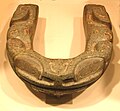Yoke stone

The U-shaped yoke stone (also called “ Mesoamerican yugo ”; Spanish yugo ) is a stone copy of the actual hip protector - probably made of fur, leather or fabric - of pre-Columbian ball players, presumably intended for rituals or ceremonies . However, some researchers are quite inclined to believe that the approximately 15-20 kg stones - wrapped in straps and / or cloths - were also carried during the game.
Occurrence
Yoke stones were found in numerous cultural centers in Mesoamerica; today most of them are in museums in the USA , Mexico , Guatemala and Copán (Honduras).
Dating
The preserved yoke stones can not be dated exactly due to missing calendar information; most of them come from the late classical period of the Mesoamerican cultures (approx. 700–900 AD).
Manufacturing
In the bronze - and ironless world of Central America, the basalt or hard sandstone , richly decorated with zoomorphic or geometric patterns, was probably provided with artistically designed preliminary drawings after the production of the mostly slightly beveled blank and then carved with stone axes and fist stones; at the end they were sanded smooth and polished.
Examples
literature
- Glyn Daniel : Encyclopedia of Archeology; a reference work with over 1800 terms, images, maps and plans. Nikol, Hamburg 1998, p. 65, ISBN 3-930656-37-X .
- Gerard W. van Bussel: The ball from Xibalba. The Mesoamerican ball game. Art History Museum with Museum of Ethnology and Austrian Theater Museum, Vienna 2002.
- Heidi Linden: The ball game in cult and mythology of the Mesoamerican peoples. Weidmann, Hildesheim 1993, ISBN 3-615-00076-5 .






